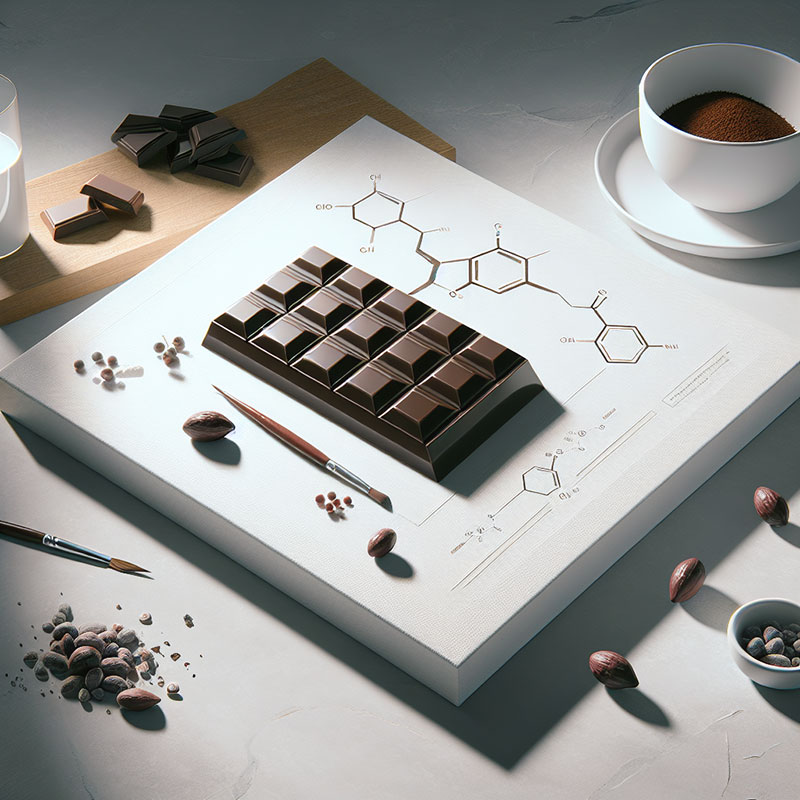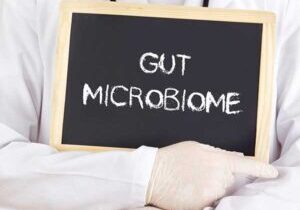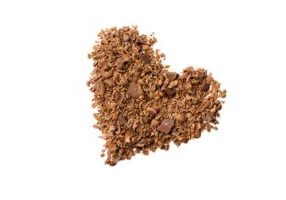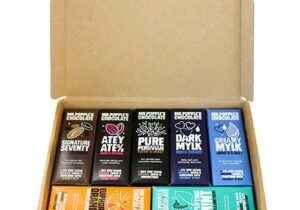BLOG
A Guide to Chocolate With High Levels of Polyphenols and Antioxidants

Dark chocolate is not only delicious, but also packed with beneficial compounds like polyphenols and antioxidants.
These powerful substances are found naturally in the cacao bean, but they can be easily destroyed by the high heat used in traditional chocolate making.
That’s why at Mr Popple’s Chocolate, we carefully craft our bars using only raw, unroasted cacao to preserve these vital nutrients.
A study by Oxford Brookes University found that our raw (unroasted) chocolate bars contain significantly higher levels of antioxidants and polyphenols compared to leading UK dark chocolate brands.
What are Polyphenols and Antioxidants?
Polyphenols are a class of micronutrients found in plant-based foods like fruits, vegetables, and, of course, cacao beans. They’re known for their powerful antioxidant properties, which help neutralize harmful free radicals in the body.
Antioxidants, on the other hand, are substances that protect cells from damage caused by these unstable free radicals.
Free radicals are unstable molecules that can wreak havoc on your body if left unchecked. They are generated through normal metabolic processes, as well as exposure to environmental toxins like pollution and UV radiation. When free radicals accumulate, they can damage cells, proteins, and even DNA, leading to a host of health issues such as inflammation, premature aging, and chronic diseases.
The higher the concentration of polyphenols and antioxidants in your chocolate, the more effective it is at combating the detrimental effects of free radicals.
At Mr Popple’s Chocolate, we take great pride in crafting raw organic chocolate that is exceptionally rich in these health-promoting compounds.
Raw cacao is an exceptional source of both polyphenols and antioxidants. In fact, it contains up to 50 mg of polyphenols per gram – more than most other foods.
Our artisanal, low temperature processes ensures that our chocolate retains the maximum amount of polyphenols and antioxidants, providing you with chocolate that not only tastes great, but also supports your overall well-being.
The Benefits of Polyphenols and Antioxidants
Polyphenols and antioxidants work together to support your overall health and well-being. These compounds have been shown to:
- Scavenge free radicals and reduce oxidative stress
- Protect DNA from damage
- Reduce inflammation in the body
- Improve cardiovascular health by lowering blood pressure and cholesterol levels
By incorporating raw chocolate such as Mr Popple’s Chocolate into your diet, you’re providing your body with a natural source of these essential nutrients.
Our Pure Peruvian 100% chocolate bar is made with nothing else but 100% raw criollo cacao.
And with our Atey Ate%, Signature Seventy, and 70% Euphoric Orange bars, you can enjoy the rich, complex flavour of raw cacao combined with the subtle sweetness of low-glycemic yacon syrup.
Our Dark Mylk chocolate bar balances the rich flavour of cacao and with creamy oat and rice milks, and is naturally sweetened with coconut blossom sugar.
The Power of Raw Cacao
Raw cacao is the unsung hero of the chocolate world, packed with a potent array of antioxidants, polyphenols, and mood-boosting compounds that set it apart from its roasted counterpart.
Unlike traditional chocolate makers who subject their beans to high temperatures, we at Mr Popple’s Chocolate have chosen to preserve the raw, unroasted essence of these precious cacao nibs, ensuring that every bite of our bars is an expression of their unadulterated flavour and health-boosting properties.
The benefits of raw cacao are numerous and well-documented. Studies have shown that unroasted cacao contains significantly higher levels of antioxidants and polyphenols compared to roasted beans. These powerful compounds work tirelessly to combat oxidative stress, reduce inflammation, and protect your cells from the damaging effects of free radicals. By incorporating raw cacao into your diet, you’re not only treating your taste buds but also nourishing your body with nature’s most potent antioxidants.
The Science Behind Raw Chocolate
A recent study conducted by Oxford Brookes University has shed light on the benefits of raw chocolate.
The researchers compared the antioxidant and polyphenol content of Mr Popple’s Chocolate to four leading UK dark chocolate brands, and the results were significant.
Our raw chocolate bars boasted significantly higher levels of these beneficial compounds, outperforming the other premium brands on the market.
The implications of this study are clear: when it comes to chocolate, raw is the way to go.
Methodology and Sample Preparation
The researchers at Oxford Brookes University meticulously prepared each chocolate sample for analysis. They weighed out precisely 0.2 grams of each product and extracted the antioxidant compounds using a 70% acetone solution. This extraction process lasted for 2 hours at room temperature in a shaking water bath, ensuring that all the beneficial compounds were effectively isolated from the chocolate matrix.
After extraction, the samples were centrifuged at 3000xg for 10 minutes, and the supernatant (the liquid containing the extracted antioxidants) was carefully removed and stored at -20°C until further analysis. This rigorous sample preparation protocol guaranteed that the subsequent measurements would accurately reflect the antioxidant content of each chocolate product.
Measuring Total Polyphenol Content, Antioxidant Capacity, and Free Radical Scavenging Activity
The Oxford Brookes study employed three key assays to comprehensively evaluate the antioxidant properties of the chocolate samples:
- Total Polyphenol Content: Using the Folin-Ciocalteau method, the researchers determined the total polyphenol content of each chocolate extract. This colorimetric assay measures the reduction of metal oxides by polyphenols, producing a blue color that can be quantified spectrophotometrically. The intensity of the color change is directly proportional to the concentration of polyphenols in the sample.
- Ferric-Ion Reducing Antioxidant Power (FRAP) Assay: The FRAP assay assessed the total antioxidant capacity of the chocolate extracts. This method relies on the ability of antioxidants to reduce ferric ions (Fe III) to ferrous ions (Fe II), inducing a color change that can be measured. The FRAP assay provides a comprehensive measure of the “total” reducing power of the antioxidants present in each chocolate sample.
- Free Radical Scavenging Activity (DPPH Inhibition Assay): The DPPH assay evaluated the ability of the chocolate extracts to neutralize free radicals. DPPH is a stable, purple-colored radical that turns colorless when antioxidants donate electrons to it. The percentage of DPPH inhibition by each chocolate sample was calculated, providing a direct measure of its free radical scavenging potential.
By employing these three complementary assays, the Oxford Brookes study provided a robust and comprehensive assessment of the antioxidant properties of the selected chocolate brands.
Highest Polyphenol Content Compared to Other Brands
The results speak for themselves: Mr Popple’s Chocolate contains a staggering 2718.05 mg GAE/100g of polyphenols, surpassing all other brands tested. When compared to Brands B, C and D, our chocolate boasts an impressive 18% higher polyphenol content. The difference is even more pronounced when compared to Brand E, with Mr Popple’s Chocolate offering a remarkable 36% more polyphenols.
The results of this study shed light on the remarkable health benefits of Mr Popple’s Chocolate and its superior antioxidant content compared to other leading brands.
Superior Antioxidant Capacity and Free Radical Fighting Power
In addition to its exceptional polyphenol content, Mr Popple’s Chocolate also demonstrates superior antioxidant capacity and free radical fighting power.
The FRAP assay, which measures the total reducing power of antioxidants, revealed that our chocolate has a 23% higher antioxidant capacity compared to Brand B and 43% higher capacity than Brand E.
Furthermore, the DPPH inhibition assay, which assesses the ability of antioxidants to neutralize free radicals, showcased Mr Popple’s Chocolate’s unrivaled free radical scavenging activity. Our chocolate exhibited a significantly higher DPPH inhibition percentage compared to Brand E, underlining its superior antioxidant properties.
The Importance of Low-Temperature Processing
At Mr Popple’s Chocolate, we believe that true indulgence should never come at the cost of quality or nutritional value. That’s why we’ve made it our mission to craft our chocolate using low-temperature processing methods that preserve the integrity of our raw cacao.
Unlike traditional chocolate makers who rely on high-heat roasting to develop their flavours, we employ a gentle, artisanal approach that allows the natural complexity of our beans to shine through.
By keeping our cacao below 42°C throughout the entire production process, we’re able to retain the precious antioxidants, polyphenols, and mood-boosting compounds that make raw chocolate such a nutritional powerhouse.
By choosing our raw, unroasted chocolate that is stone ground at low temperatures, you’re making a conscious choice to nourish your body with nature’s most potent antioxidants and polyphenols.
It’s a small step that can have a big impact on your overall health and well-being, supporting everything from heart health to cognitive function and mood.
The Benefits of Choosing Chocolate High in Antioxidants and Polyphenols
From promoting heart health to supporting brain function, the powerful compounds found in chocolate that’s rich in antioxidants and polyphenols can have a profound impact on your overall well-being.
Promoting Heart Health and Circulation
One of the most notable benefits of consuming chocolate high in antioxidants and polyphenols is its potential to promote cardiovascular health. The flavanols found in cocoa have been shown to improve endothelial function, which is crucial for maintaining healthy blood vessels and optimal circulation. By supporting the health of your arteries and veins, antioxidant-rich chocolate may help reduce the risk of heart disease and other cardiovascular issues.
Supporting Brain Function and Cognitive Performance
In addition to its heart-healthy properties, the polyphenols in chocolate may also have a positive impact on brain function and cognitive performance. Studies have suggested that the flavanols in cocoa can improve blood flow to the brain, enhancing cognitive function and memory.
Eating a square of Mr Popple’s Chocolate may not only satisfy your sweet tooth but also give your brain a boost, helping you stay sharp and focused throughout the day.
Enhancing Mood and Reducing Stress Levels
Have you ever noticed how a bite of chocolate can instantly lift your spirits? It turns out that there’s a scientific reason behind this phenomenon.
Additionally, the magnesium content in chocolate may help reduce stress levels and promote a sense of calm and relaxation.
Give your mood a delightful boost by enjoying a piece of Mr Popple’s Chocolate,.
Potential Anti-Inflammatory and Anti-Cancer Properties
While more research is needed, some studies have suggested that the polyphenols in chocolate may possess anti-inflammatory and anti-cancer properties.
Inflammation is a key factor in many chronic diseases, and the antioxidants in chocolate may help combat this by neutralizing harmful free radicals. Furthermore, certain polyphenols found in cocoa have been shown to have potential anti-cancer effects, though further studies are required to fully understand these mechanisms.
So, go ahead and savour a square from our artisanal, high antioxidant and high polyphenol chocolate bars, knowing that you’re treating yourself to a delicious and health-promoting experience.
Key Takeaways
- Mr Popple’s Chocolate, crafted with passion and expertise from raw organic cacao since since 2007, stands out as the antioxidant champion among popular chocolate brands.
- The Oxford Brookes study revealed that Mr Popple’s Chocolate contains the highest levels of polyphenols, outshining competitors from leading, high quality UK dark chocolate brands.
- Mr Popple’s Chocolate also demonstrated superior antioxidant capacity and free radical scavenging activity compared to the other brands
- Consuming chocolate rich in antioxidants and polyphenols, like Mr Popple’s Chocolate, offers numerous potential health benefits:
- Promoting heart health and circulation by improving endothelial function and reducing the risk of cardiovascular issues.
- Supporting brain function and cognitive performance by enhancing blood flow to the brain and boosting memory.
- Enhancing mood and reducing stress levels by stimulating the release of endorphins and promoting a sense of calm and relaxation.
- Potential anti-inflammatory and anti-cancer properties, though further research is needed to fully understand these mechanisms.
- The artisanal touch, low temperature processes and commitment to quality ingredients set Mr Popple’s Chocolate apart, ensuring that the final product retains the maximum amount of health-promoting polyphenols and antioxidants.
- By indulging in a square of Mr Popple’s Chocolate, you’re not only treating yourself to a moment of pure bliss but also nourishing your body with possibly the most antioxidant-rich chocolate on the market.
- Choosing Mr Popple’s Chocolate allows you to savour a delicious and health-promoting experience, knowing that you’re supporting your body’s natural defences against disease with every bite.
FAQs
1. What is the purpose of this study?
The purpose of this study is to compare the polyphenol content, total antioxidant capacity, and free radical scavenging activity of five different chocolate products.
2. Who conducted the study?
The study was conducted by Dr Sangeetha Thondre from the Oxford Brookes Centre for Nutrition and Health.
3. Which chocolate products were included in the study?
The study included Mr Popple’s Chocolate and 4 other leading UK dark chocolate brands.
4. What are polyphenols, and why are they important?
Polyphenols are potent antioxidants that may have beneficial effects beyond their antioxidant abilities, such as involvement in cellular signalling, anti-inflammatory properties, and enhancing endothelial function.
5. How were the chocolate samples prepared for analysis?
The chocolate samples were weighed (0.2 ± 0.01 g) and extracted with 4 mL of 70% acetone for 2 hours at room temperature in a shaking water bath.
6. What method was used to determine the total polyphenol content?
The total polyphenol content was determined using the Folin-Ciocalteau method, a colorimetric assay based on the reduction of metal oxides in the Folin-Ciocalteau reagent.
7. How was the total antioxidant capacity of the samples determined?
The total antioxidant capacity was determined using a modification of the Ferric-ion reducing antioxidant power (FRAP) assay.
8. What is the DPPH inhibition assay, and what does it measure?
The DPPH (2,2-diphenyl-1-picrylhydrazyl) inhibition assay is a measure of free radical scavenging activity. It assesses the ability of antioxidants present in the chocolate samples to neutralize free radicals.
9. Which statistical tests were used to analyze the data?
The data were analyzed using one-way ANOVA followed by a post hoc Tukey test for normally distributed data (total polyphenol content) and the non-parametric Kruskal-Wallis test for data that were not normally distributed (FRAP analysis and DPPH inhibition assay).
10. Was there a significant difference in total polyphenol content, total antioxidant capacity, and free radical scavenging activity between the chocolate products?
Yes, there was an overall significant difference between the chocolate products in total polyphenol content, total antioxidant capacity, and DPPH inhibition (P<0.001)
11. Which chocolate product had the highest total polyphenol content?
Mr Popple’s Chocolate had the highest total polyphenol content among the tested products.
12. How much higher was the total polyphenol content of Mr Popple’s Chocolate compared to the other products?
Mr Popple’s Chocolate had 18% higher polyphenol content compared to brands B, C, and D, and 36% higher than Brand E.
13. Which chocolate product had the highest total antioxidant capacity?
Mr Popple’s Chocolate had the highest total antioxidant capacity among the tested products.
14. How much higher was the total antioxidant capacity of Mr Popple’s Chocolate compared to Brands B and E?
Mr Popple’s Chocolate had 23% higher total antioxidant capacity compared to Green & Black’s 85% Cocoa and 43% higher than Lindt 90% Cocoa.
15. Which chocolate products had the highest DPPH inhibition percentage?
Mr Popple’s Chocolate and Brand D had the highest DPPH inhibition percentage among the tested products.
16. How much higher was the DPPH inhibition percentage of Mr Popple’s Chocolate bar compared to Brand E?
Mr Popple’s Chocolate had a 2% higher DPPH inhibition percentage compared to Brand E.
17. What do the results of this study suggest about the health benefits of Mr Popple’s Chocolate?
The results suggest that Mr Popple’s Chocolate may have greater potential health benefits compared to the other tested products due to its higher polyphenol content, total antioxidant capacity, and free radical scavenging activity.
18. Can the results of this study be generalized to all chocolate products?
No, the results of this study are specific to the five chocolate products tested and cannot be generalized to all chocolate products.
19. Are there any limitations to this study?
The study does not mention any specific limitations. However, it is important to note that the results are based on in vitro analyses and may not directly translate to in vivo effects.
20. What further research could be conducted based on the findings of this study?
Further research could investigate the specific polyphenol compounds present in the chocolate products, as well as their bioavailability and potential health effects in human studies.










